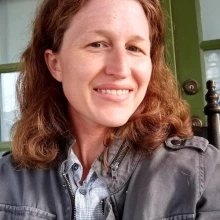2022 Dozier Recipients
Congratulations to Rebecca Wey, Sarah Renkert, and Barvick, the 2022 School of Anthropology Dozier Award recipients! Rebecca and Sarah’s paper tied for the first place award, which includes a $500 prize; Kate’s paper received second place and a $250 prize. All three awardees are encouraged to publicly present their work through the departmental lecture series during the 2022–2023 academic year. The titles and abstracts of the three award-receiving papers are below.
Professor Edward Dozier was a research anthropologist, a supportive teacher, and generally respected by all. Since 1973 the SoA has celebrated his life and contribution to anthropology with the Dozier award for the best graduate student paper. This is an appropriate award given his constant mentorship of students, especially those from other cultures. As one of the first indigenous anthropologists, Dozier conveyed through his research the value of both the Insider (emic) and the Outsider (etic) perspectives in anthropology.

Rebecca Wey, Politics of Desire: Psychoanalytic Language in the Argentine Abortion Debate
Abstract: The widespread social diffusion of psychoanalysis in Argentina has been called, variously, a Weltanschauung, a culture, and an obsession. An examination of psychoanalytic language used in a national abortion debate illuminates political effects of this diffusion and their inherent instability. Feminist activists deployed a specific understanding of desire as a zone of ultimate autonomy, beyond the reach of norms, institutions or the state. I offer a close reading of what may be called the argument of desire, an argument that transcends the traditional terms of the debate. Its key concept, desire, has even broader circulation and its own political consequences: the emergence of a subject of complicated agency, who does not choose so much as is chosen, and a heterogeneous collective as militant political unit, a unification of differently desiring dissidents.

Sarah Renkert, False Generosity: A Freirean Reflection on Food Aid and Lima’s Comedores Populares
Abstract: Paulo Freire is known for his liberatory approach to education. However, less discussed are his reflections on charitable giving, aid, and welfare programs, which he critiques for their ‘false generosity.’ Freire argues that superficially ‘generous’ acts of giving are often ‘false,’ because this ‘generosity’ serves to uphold uneven power dynamics and the economic status quo, maintaining the oppressed in a position of manipulability and dependency. The distribution of aid by populist state actors is often rife with acts of paternalistic ‘false generosity,’ allowing politicians to use their positions of power to reap benefits from recipients. Turning to Perú’s state-sponsored comedores populares (communal kitchens which distribute state-subsidized food aid), this article considers how state actors have employed “false generosity,” to build political loyalty while seeking to control an unpaid labor force that upholds a seemingly benevolent image of the “generous” state. Photo: Sarah helping prepare mondonguito a la italiana for a comedor lunch

Kate Barvick, Crafting in Clay: A Geometric Morphometric Analysis of Ancestral Pueblo Water Jars
Abstract: During the 1000s-1300s CE, population in the Ancestral Pueblo world rose to its peak in the northern US Southwest. Settlement and building patterns changed, and people maintained broad networks of trade and movement. Their social networks lend insights to how people from socioculturally diverse areas interacted with each other and shared technological knowledge.
In this paper I examine relationships between the people of three sub-regions of the Ancestral Pueblo world during this time, using a lens of communities of practice (Lave and Wenger 1991; Wenger 1998). A common way of writing about the people of this time period is to talk about the Kayenta, the Tusayan, the Mesa Verdeans, as culture areas; relationships are described as between the Kayenta Region and Mesa Verde. However, each region was home to a diverse population, who lived in small and periodically mobile settlements with strong social networks. More nuanced examinations of the relationships of the people within and between the different regions can re-frame our understanding of how people related to each other that goes beyond traditional culture area approaches (Feinman and Neitzel 2020).
Using two-dimensional landmark-based Geometric Morphometrics (Adams et al. 2014; Zelditch et al. 2012) to analyze the profiles of decorated ceramic water storage jars, I explore the communities of pottery creation and how they existed and changed in the Kayenta, Tusayan, and Western/Central Mesa Verde areas. Using a sample of 100 vessels of three common decorated wares recovered from five different hydrological basins around the Four Corners area of the US Southwest, I set landmarks along the profile outlines to quantify the vessels’ shape and compare morphological similarities by location, ware, and time period. Studying shape emphasizes the motor skills of pottery formation that were learned and internalized through interactive engagement with skilled potters and elders. In this way, I focus on skills that were learned and shared within communities. These patterns show how social boundaries were understood and defined in the Ancestral Pueblo Southwest. Ultimately there was a large amount of variation among technologies, shared over a wide area in the northern southwest, without sharp boundaries between discrete regions.

